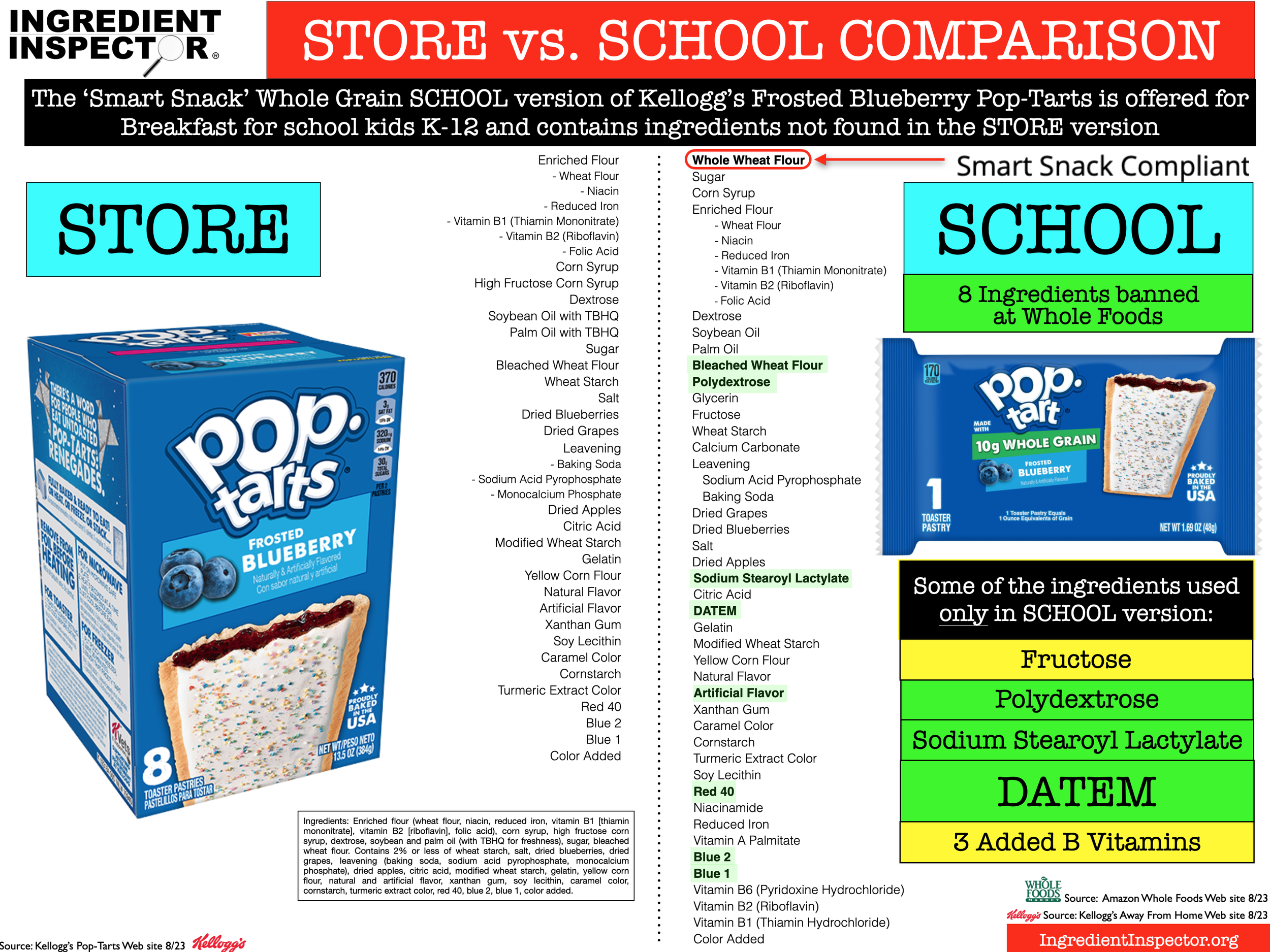SMART SNACKS IN SCHOOL ARE NOT-SO-SMART
SMART SNACK SCHOOL STANDARDS CASE STUDY #1: KELLOGG’S POP-TARTS
information updated August 2023
The American Heart Association is one of the founders of Alliance for a Healthier Generation.
Designed to promote healthy eating among U.S. School children K-12, Government standards for Smart Snacks are unwittingly encouraging the creation and availability of less healthy food products for all U.S. school children.
Sources for Standards: Alliance for a Healthier Generation 8/23; American Heart Association 2023
Alliance for a Healthier Generation was founded by the American Heart Association and the Clinton Foundation in 2005. The admirable goals are to empower kids to develop lifelong healthy habits, including healthy eating.
Smart Snacks Standards: One of the elements which emerged from the Alliance for a Healthier Generation is something called the ‘Smart Snacks Standards’ for schools K-12.
The Smart Snacks Standards are designed to approve only certain snacks and entrées for Schools if they meet specific ingredient criteria which was designed in conjunction with the U.S. Department of Agriculture (USDA).
Seen below >> ‘Smart Snack’ Ingredient and Nutrition Standards: One of the “general” ways a product can get ‘Smart Snack’ approval for school is for Whole Grain to be the first ingredient at 50% or more by weight (this is what Kellogg’s Whole Grain Pop-Tarts do).
Other possible criteria for ‘Smart Snack’ approval include these specific items:
Have as the first ingredient a fruit, a vegetable or a dairy product or a protein food; or
Be a combination food that contains at least 1/4 cup of fruit and/or vegetable.
After meeting any one of the above criteria, the item must then meet specific nutrient standards:
The food must meet the nutrient standards for calories, sodium, sugar and fats.
‘Smart Snack’ Sugar Standard: Regarding sugar, the ‘Smart Snacks Standard’ for Sugar content in snacks and entrées is 35% by weight or less.
So . . . this means it’s okay for a Smart Snack approved snack or entrée to be over 1/3 Sugar by weight.
Unintended Consequences
Since the enforcement of the Smart Snacks Standards, two key corporate behaviors have resulted:
This ‘Smart Snack’ government mandate incentivized many food manufacturers to create specific “School” versions of products with Whole Grains as the number one ingredient. In order to meet school guidelines, many Big Food manufacturers have created new specific “School” versions of products. Upon close inspection, we see that many of the “School” versions have less healthy or not more healthy ingredients than the original grocery “Store” versions.
2. Food and beverage manufacturers have recognized the “loopholes” of the Smart Snacks Standards and are working around them to sell less healthy options to U.S. school children. The Standards are not stringent or specific enough to achieve their intended objective. Smart Snack Standards enable the approval of many commercial ingredients which we never use at home and ingredients which are recognized to be harmful such as MSG, BHT and High Fructose Corn Syrup.
Instead of starting with the objective — healthy eating — start with the target >> U.S. school children.
At the foundation of designing a new Smart Snack program for kids, it is essential to understand the complicated dynamics of what drives kids’ purchase decisions and eating + drinking preferences.
Kids Are in Control: Most kids find a way to get what they want when it comes to food and drink. Just look inside grocery carts and you can tell if there are kids in the house because there will be tell-tale products like snack bars, sugary cereals, flavored yogurts, juices, sports drinks, snacks, cookies, peanut butter, jelly, frozen pizza, frozen snacks and mac & cheese. These are high consumption kid categories.
Many Brands exist solely for “Kid Appeal” such as Fruit Roll-Ups, Cocoa Puffs, Go-Gurt, Pizza Rolls, Lunchables, Jell-O Play and Capri Sun, to name a few.
When a food product is one of a child’s favorites, these kid users have deep and complex sensory knowledge about the product in their memories, both conscious and subconscious. They know every detail of how this product tastes, feels, smells and looks. If they've eaten 100 Kellogg’s Pop-Tarts or 100 Burger King Whopper Jrs, they know exactly what to expect when they get one in their mouths. Meeting these taste expectations is crucial for successful products. Consistency is key.
Whereas adults tend to have a broader set of acceptable food items in any given category:
“If they’re out of the vanilla ice cream, get caramel instead.”
Kids have very specific flavor and Brand requests:
“It has to be Fanta Orange Soda. Only Fanta! I don’t like Orange Crush.”
“If they’re out of Double Stuf Oreos, ugh! I don’t know. Could you go somewhere else and find them for me?”
U.S. Children and Nutrition: Kids in the U.S. have rarely been concerned with nutrition. They never really think about nutrition unless, maybe, they’re an athlete, they have High Health Conscious parents or they live in a High Health Conscious area in pockets of the West coast.
On the surface, implementing a nutritional standard for school foods seems like a great idea. But, remember . . . whereas adults eat certain things for the nutritional benefits, children do not.
When choosing something healthy, adults will rationalize that any sub-optimal taste is worth the benefit. Kids always choose taste first.
In simple terms, many adults will eat broccoli even if they hate the taste because they know it’s good for them.
Kids will not eat the broccoli if they don’t like the taste, and most kids couldn’t care less that broccoli is good for them.
KELLOGG’S POP-TARTS #1 Toaster Pastries in the U.S. (Source: Statista 2023)
Imagine you are a food manufacturer of a favorite food of kids and it can be distributed and sold in schools only if the first ingredient is Whole Grains. Unfortunately for you, your existing product does not start with Whole Grains. You will have to reformulate a new version of the product in order to get distribution in schools.
Now, imagine that you are at The Kellogg Company and need to reformulate Pop-Tarts with Whole Grains as the first ingredient to become eligible to be sold in schools.
The first ingredient of the Pop-Tarts you currently make for sale in the store is Enriched Flour. However, since it is a requirement for the School version to have Whole Grain as the #1 ingredient, you switch the first ingredient to Whole Wheat Flour for the School Pop-Tarts.
It is inevitable kids will try and reject these Pop-Tarts if the only change you make is Whole Wheat Flour. The kids will know immediately the outside crust is not the same.
So, in order to be accepted by these school kids, other ingredient changes must be made to deliver on their taste expectations. The toaster pastry must be made to taste as close as possible to the original. Kellogg doesn’t want kids to even suspect it could have a different taste from what they are used to; Kellogg wants to avoid the contemplation that a ‘Whole Grain’ Pop-Tarts may be a compromised Pop-Tarts experience.
In efforts to create a kid-acceptable School Pop-Tarts with Whole Wheat Flour as the first ingredient, Kellogg changed the ingredients to compensate for the taste shift from switching to Whole Wheat Flour.
As a result, kids now have a ‘Smart Snack’-approved Pop-Tarts which has even more ingredients than the Store version and just as many ingredients banned at Whole Foods, albeit different ones.
The Corporate Dilemma
The goal of ‘Smart Snack’ is to create access to healthy products for kids, but if, for example, the only change a company makes is to change the first ingredient to Whole Wheat Flour, school kids will reject it. It’s like trying to switch a kid from their favorite white bread to wheat bread without them realizing . . . good luck.
The Smart Snack requirements force the hand of the food and beverage companies: If Kellogg wants distribution of Pop-Tarts in schools, making the first ingredient Whole Wheat Flour necessitates additional ingredient changes to remain acceptable to kids.
‘Smart Snack’ Pop-Tarts for Schools: Today, Kellogg makes specific Pop-Tarts for Stores and other specific ‘Smart Snack’ Whole Grain Pop-Tarts for Schools.
The Frosted Blueberry Pop-Tart you see below right is available in schools across the U.S. for Breakfast and are ‘Smart Snack Compliant’.
Q: How can these Pop-Tarts be called a healthy and smart choice for breakfast at school? What does this tell school-age children about what is actually healthy?
These Whole Grain Frosted Blueberry Pop-Tarts are Smart Snack Compliant . . . even though they contain 8 ingredients banned at Whole Foods and ingredients banned at Whole Foods which are not found in the STORE version.
MORE ADDED SUGAR THAN THE AHA RECOMMENDS: Some Whole Grain Kellogg’s Pop-Tarts in School contain 30-31 grams of Added Sugar per serving, such as the Pop-Tarts Whole Grain Frosted Cinnamon and Whole Grain Frosted Fudge (seen below).
The American Heart Association recommends that children have 25 grams or less of Added Sugar daily. Since these varieties are not fruit-based, there is no sugar coming naturally from fruit. This is all Added Sugar.
Eating these Whole Grain Frosted Pop-Tarts sold in schools is more than the amount of Added Sugar recommended by the American Heart Association for a child for an entire day.
Q: How are these Pop-Tarts sold to K-12 when they have so much Sugar?
A: Because the Standard for Smart Snacks is not based on grams of Sugar . . . it is based on Sugar as a % of the total weight >> the Sugar content must be 35% or less of the weight and these Pop-Tarts meet that criteria.
Sources: The Kellogg Company provided data on Commercial Food Systems Web site 2/22; AHA 2022
Here are some sales materials from The Kellogg Company targeted at schools to sell Whole Grain Pop-Tarts and other offerings from Kellogg:
Following is The Kellogg Company Mission for K-12:
One of the reasons U.S. kids are so addicted to Sugar? See the Ingredient Inspector review of #1 U.S. Baby Food, Gerber:
IDEAL NEXT STEPS: The well-intended vision of the Alliance for a Healthier Generation must be re-visited and revised with the guidance of the Institute of Medicine in collaboration with kid target and ingredient experts with Big Food experience plus the vision and insights of organizations such as the Juvenile Diabetes Research Foundation.
Discover food + beverages whose ingredients are Closest To Homemade in 275+ categories >> manufactured food + beverages whose ingredients are closest to those we would use at home to make the item. Neither money nor products are ever accepted to appear on the Closest To Homemade list.
Contact and follow us at:















